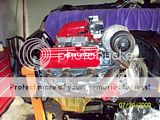I'd like to correct a misconception, The Stage 1 block is not based off the production block. In fact, the same Heavy Duty raw casting was used to produce both Stage 1 and Stage 2 blocks (offcenter versions 0012 and 0016).
I've owned several 0016 S1 and S2 offcenter blocks, and I've spent some time studying the different versions of the block: Here are a few of my observations:
The Stage 1 version of the block was machined with the oil passages in the production locations, The oil main galleys intersect the lifter bores just like the production block. The oil pump pickup was located at the #2 main bulkhead just like production (but had an unmachined pad at the #1 main bulkhead). S1's had only 8 head bolt holes machined (but had provisions for all 14), and had 2 bolt cast iron main caps in all 4 positions.
Why did Buick even bother producing a Stage 1 block? Why not build all Stage 2 blocks? My guess is that the "Stage" casting could easily be machined in Plant 36 (Buick's Engine Plant) on production tooling to make the Stage 1 version. I'm thinking Stage 2 versions needed extra machining and could not run down the production line in Plant 36. I regularly saw pallets of Stage 2 blocks in the prototype machining area in the Engineering building. I beleive that is where all Stage 2 blocks were machined. I don't recall seeing any Stage 1's in that area.
The Stage 2 version of the block was machined with the oil galleys set outside the lifter bores, all 14 head bolt holes, and the stock oil pickup passage was machined away for the 4 bolt billet steel center caps. The oil pump pickup pad at the #1 main position was machined for wet sump operation. Oil feed passages were drilled and tapped in the towers at the front and rear of the block for wet sump oiling systems.
The later S2 0016 blocks had many other changes.......Buick was constantly fine tuning the Stage 2 blocks, batch by batch. I've confirmed this during conversations with George Montgomery (Indy Lights Engine builder) and Denny Manner (Buick Engine- Chief Engineer)
I wish I'd have bought a pallet of these blocks back when I had the chance!!!!! But who knew??
Dave


